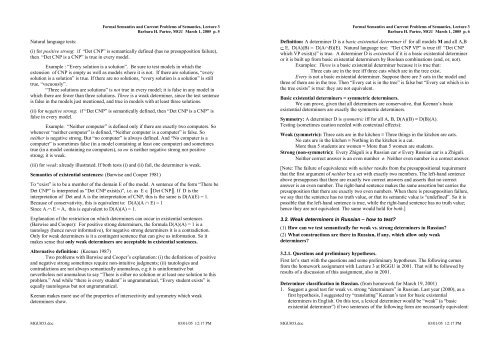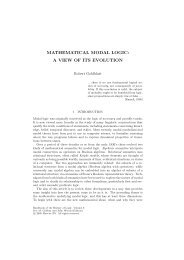Lecture 3. Noun Phrases and Generalized Quantifiers
Lecture 3. Noun Phrases and Generalized Quantifiers
Lecture 3. Noun Phrases and Generalized Quantifiers
- No tags were found...
Create successful ePaper yourself
Turn your PDF publications into a flip-book with our unique Google optimized e-Paper software.
Natural language tests:Formal Semantics <strong>and</strong> Current Problems of Semantics, <strong>Lecture</strong> 3Barbara H. Partee, MGU March 1, 2005 p. 5(i) for positive strong: if “Det CNP” is semantically defined (has no presupposition failure),then “Det CNP is a CNP” is true in every model.Example : “Every solution is a solution”. Be sure to test models in which theextension of CNP is empty as well as models where it is not. If there are solutions, “everysolution is a solution” is true. If there are no solutions, “every solution is a solution” is stilltrue, “vacuously”.“Three solutions are solutions” is not true in every model; it is false in any model inwhich there are fewer than three solutions. Three is a weak determiner, since the test sentenceis false in the models just mentioned, <strong>and</strong> true in models with at least three solutions.(ii) for negative strong: if “Det CNP” is semantically defined, then “Det CNP is a CNP” isfalse in every model.Example: “Neither computer” is defined only if there are exactly two computers. Sowhenever “neither computer” is defined, “Neither computer is a computer” is false. Soneither is negative strong. But “no computer” is always defined. And “No computer is acomputer” is sometimes false (in a model containing at least one computer) <strong>and</strong> sometimestrue (in a model containing no computers), so no is neither negative strong nor positivestrong; it is weak.(iii) for weak: already illustrated. If both tests (i) <strong>and</strong> (ii) fail, the determiner is weak.Semantics of existential sentences: (Barwise <strong>and</strong> Cooper 1981)To “exist” is to be a member of the domain E of the model. A sentence of the form “There beDet CNP” is interpreted as “Det CNP exist(s)”, i.e. as E ∈ ║Det CNP║. If D is theinterpretation of Det <strong>and</strong> A is the interpretation of CNP, this is the same is D(A)(E) = 1.Because of conservativity, this is equivalent to: D(A)(A ∩ E) = 1Since A ∩ E = A, this is equivalent to D(A)(A) = 1.Explanation of the restriction on which determiners can occur in existential sentences(Barwise <strong>and</strong> Cooper): For positive strong determiners, the formula D(A)(A) = 1 is atautology (hence never informative), for negative strong determiners it is a contradiction.Only for weak determiners is it a contingent sentence that can give us information. So itmakes sense that only weak determiners are acceptable in existential sentences.Alternative definition: (Keenan 1987)Two problems with Barwise <strong>and</strong> Cooper’s explanation: (i) the definitions of positive<strong>and</strong> negative strong sometimes require non-intuitive judgments; (ii) tautologies <strong>and</strong>contradictions are not always semantically anomalous, e.g it is uninformative butnevertheless not anomalous to say “There is either no solution or at least one solution to thisproblem.” And while “there is every student” is ungrammatical, “Every student exists” isequally tautologous but not ungrammatical.Keenan makes more use of the properties of intersectivity <strong>and</strong> symmetry which weakdeterminers show.Formal Semantics <strong>and</strong> Current Problems of Semantics, <strong>Lecture</strong> 3Barbara H. Partee, MGU March 1, 2005 p. 6Definition: A determiner D is a basic existential determiner if for all models M <strong>and</strong> all A,B⊆ E, D(A)(B) = D(A∩B)(E). Natural language test: “Det CNP VP” is true iff “Det CNPwhich VP exist(s)” is true. A determiner D is existential if it is a basic existential determineror it is built up from basic existential determiners by Boolean combinations (<strong>and</strong>, or, not).Examples: Three is a basic existential determiner because it is true that:Three cats are in the tree iff three cats which are in the tree exist.Every is not a basic existential determiner. Suppose there are 5 cats in the model <strong>and</strong>three of them are in the tree. Then “Every cat is in the tree” is false but “Every cat which is inthe tree exists” is true: they are not equivalent.Basic existential determiners = symmetric determiners.We can prove, given that all determiners are conservative, that Keenan’s basicexistential determiners are exactly the symmetric determiners.Symmetry: A determiner D is symmetric iff for all A, B, D(A)(B) ≡ D(B)(A).Testing (sometimes caution needed with contextual effects):Weak (symmetric): Three cats are in the kitchen ≡ Three things in the kitchen are cats.No cats are in the kitchen ≡ Nothing in the kitchen is a cat.More than 5 students are women ≡ More than 5 women are students.Strong (non-symmetric): Every Zhiguli is a Russian car ≠ Every Russian car is a Zhiguli.Neither correct answer is an even number ≠ Neither even number is a correct answer.[Note: The failure of equivalence with neither results from the presuppositional requirementthat the first argument of neither be a set with exactly two members. The left-h<strong>and</strong> sentenceabove presupposes that there are exactly two correct answers <strong>and</strong> asserts that no correctanswer is an even number. The right-h<strong>and</strong> sentence makes the same assertion but carries thepresupposition that there are exactly two even numbers. When there is presupposition failure,we say that the sentence has no truth value, or that its semantic value is “undefined”. So it ispossible that the left-h<strong>and</strong> sentence is true, while the right-h<strong>and</strong> sentence has no truth value;hence they are not equivalent. The same would hold for both.]<strong>3.</strong>2. Weak determiners in Russian – how to test?(1) How can we test semantically for weak vs. strong determiners in Russian?(2) What constructions are there in Russian, if any, which allow only weakdeterminers?<strong>3.</strong>2.1. Questions <strong>and</strong> preliminary hypotheses.First let’s start with the questions <strong>and</strong> some preliminary hypotheses. The following comesfrom the homework assignment with <strong>Lecture</strong> 3 at RGGU in 2001. That will be followed byresults of a discussion of this assignment, also in 2001.Determiner classification in Russian. (from homework for March 19, 2001)1. Suggest a good test for weak vs. strong “determiners” in Russian. Last year (2000), as afirst hypothesis, I suggested try “translating” Keenan’s test for basic existentialdeterminers in English. On this test, a lexical determiner would be “weak” (a “basicexistential determiner”) if two sentences of the following form are necessarily equivalent:MGU05<strong>3.</strong>doc 03/01/05 12:17 PMMGU05<strong>3.</strong>doc 03/01/05 12:17 PM
















